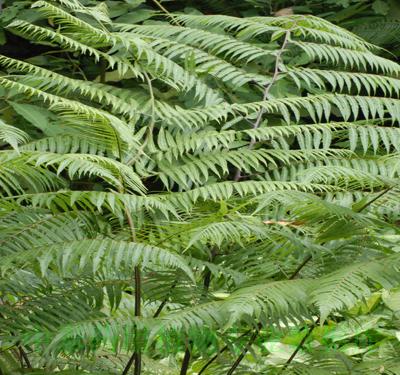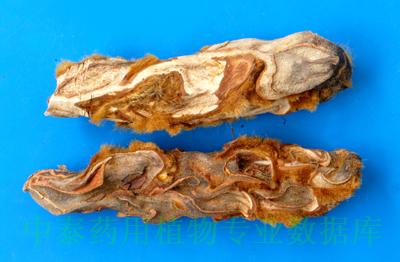| [English Name] | East Asian Tree Fern | |
| [Chinese Name] | 金毛狗脊 | |
| [Pinying Name] | Jinmaogouji | |
| [Latin Name] | Cibotii Rhizoma | |
| [Genera] | bengkejueke | |
| [Efficacy] | qufengshiyao | |
| [Pictures] | Plant picture | Drug picture |

|

|
|
| [Alias] | ||
| [Source] | ||
| [Plant morphology] | ||
| [Distribution] | ||
| [Gathering and processing] | ||
| [Characteristics] | ||
| [Ecology] | It prefers warm 、moist and shade environment.It is afraid of sever cold and avoids direct light as taboos. Air humidity should keep between 70% to 80%.Optimal growth temperature is between 16 to |
|
| [Chemical composition] | ||
| [Pharmacological activities] |
1. Inhibit Platelet Aggregation: Onychin show strong inhibit platelet aggregation. Its processed product show similar activity. And the protocatechuic acid and 3,4-dihydroxy benzaldehyde may be the activity compound[1]. 2. Activating Blood(: woodwardia and its processed product show activating blood activity[3]. 3. Analgesia: Sand scalding and nature woodwardia show significant analgesic activity. 4. Prevention Osteoporosis: Woodwardia can increase osteoplastic activity on ovariectomized rats[4]. 5. Effect on Myocardial: Woodwardia injecta can increase nutritional cardiac muscle blood flow[5]. 6. Anticancer: Xi woodwardia leaf 70% hanol extract show anticancer activity on Ehrlich's ascites carcinoma and fleshy tumor mice model[6]. 7. Other Effects: Onychin show hepatoprotective effect, scavenging free radicals[7]. This crude extract inhibit diplococcus pneumoniae and influenza viruses[8]. Hexadecanoic acid show anti-inflammatory. Linoleic Acid show reducing blood lipid activity[9]. protocatechuic acid and caffeic acid show anti-inflammatory and anti-rheumatism activity[10]. |
|
| [Clinical trial] | ||
| [Properties] | ||
| [Medical and other Uses] | ||
| [Dosage] | ||
| [Cautions] | ||
| [Traditional usage] | ||
| [Toxicological studies] | ||
| [Pharmaceutical preparations] | ||
| [References] |
Pharmacologic Actions: [2] Li J, Jia T Z, Liu J P, et al.Chinese Traditional and Herbal Drugs, 2000,31(9):678. [3] Jv Chengguo, Cao Cuixiang, Shi Lin. Chinese Traditional Patent Medicine, 2005,27(11):1279. [4] Ma Zhongshu, Wang Rui, Qiu Mingcai. Chinese Journal of Obstetrics and Gynecology, 1999,34(2):82. [5] Zhang Baoheng. China Journal of Chinese Materia Medica, 1985,10(2):42. [6] Yin Jian. Chinese Medicine Modern Research and Clinical Application. Beijing: Chinese Ancient Books Publishing House, 1997:182. [7]Oh H,Kim D H,Cho J H. J Ethnopharm,2004,95(2/3):421. [8] Jiangsu Institute of Materia Medica. Xinhua Compendium of Materia Medica(second volumes). Shanghai: Shanghai scientific & Technical Publishers, 1990:12. [9] Jia Tianzhu, Li Jun, Jie Shiquan. China Journal of Chinese Materia Medica, 1996,21(4):216. [10] Yuan Zhong, Yu Jiangtian, Su Shiwen. Journal of |
|